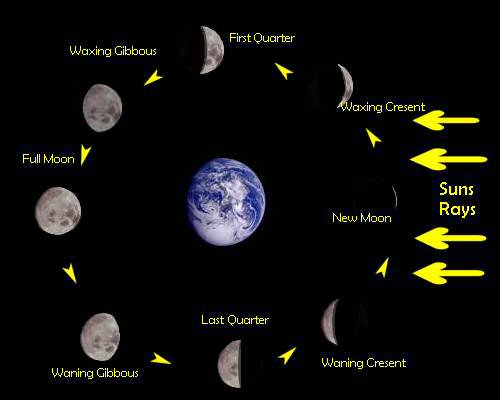Her confusion was as to why one morning she could see both the Sun and the Moon in the sky at the same time. The explanation of this isn't too difficult, but why this problem arises is obvious. If you watch the weather on TV, or look it up on the internet, then daytime weather is always indicated by a Sun, maybe with clouds in front of it (or rain if you live in Cardiff!). In turn the night is represented by the moon. This is also the case is many other places. So why is our idea of the Sun in the day and the moon at night wrong?
Image courtesy of EarthSky (http://earthsky.org). An image to illustrate the phases of the moon, but it can also be used to explain why we see the sun and moon in the same sky.
In the diagram above, the Sun is to the right. Day and Night is simply the rotation of the earth, which happens every 24 hours. The phases of the moon is the result of its orbit around the Earth, which takes about 27 days.
The diagram shows that if the Moon is between the Sun and Earth, we don't see any Light reflected off the moon, so it looks dark to us. In this case we would see the Sun and Moon in the same sky at the same time, but the moon is too dark to easily see.
In the other extreme when the Moon is on the other side of the Earth to the Sun, the Moon is fully illuminated by the Suns light. However in this situation you can never see the Sun and Moon in the same sky, as they are on opposite sides of the Earth.
However there is a range of positions of the Moon, where the Moon and Sun are in the same sky as seen on Earth, and the Sun illuminates enough of it to be seen on Earth. This is why during the day time we can see both the Sun and the Moon.
In the grand scheme of things this is not very important, but it seems a shame that we are teaching people something which is wrong. A simple alternative is to use Stars to indicate night time, but I guess as long as people understand that this is just a misconception, then we can let the Weather people have their Moon!

No comments:
Post a Comment